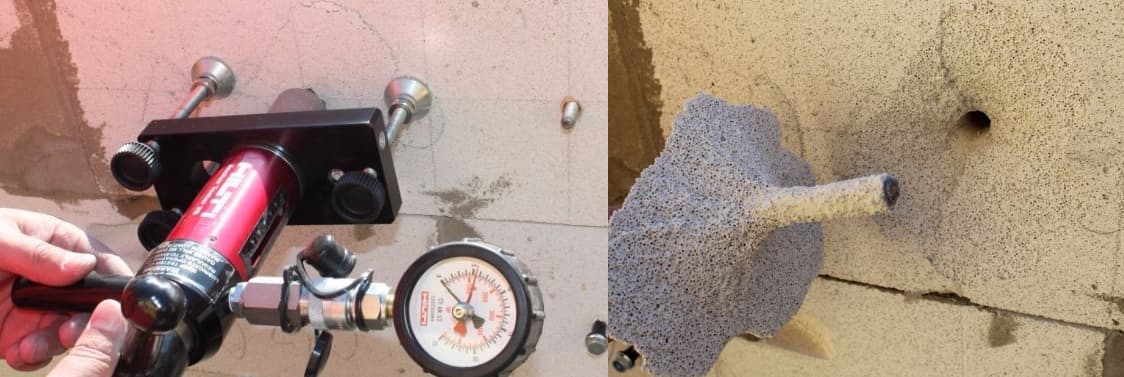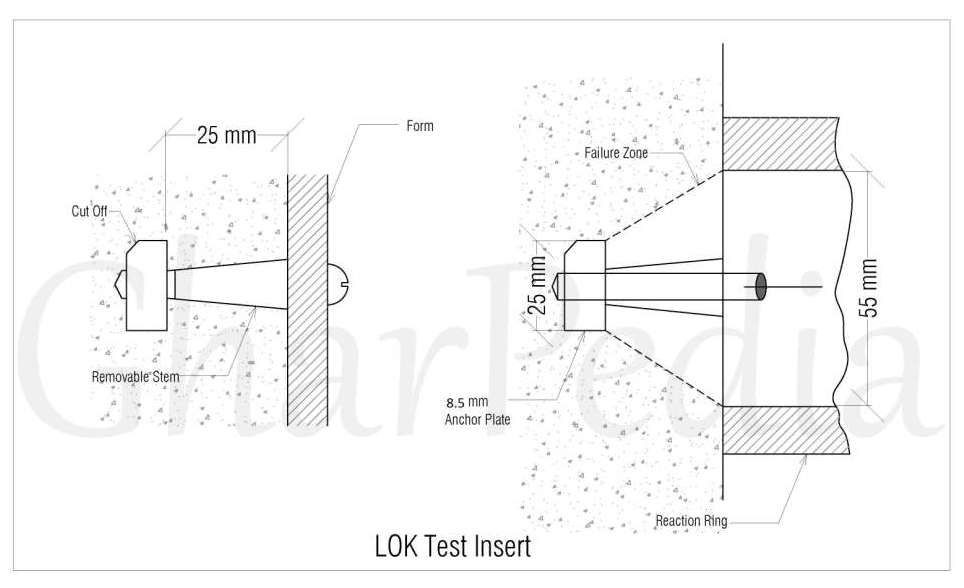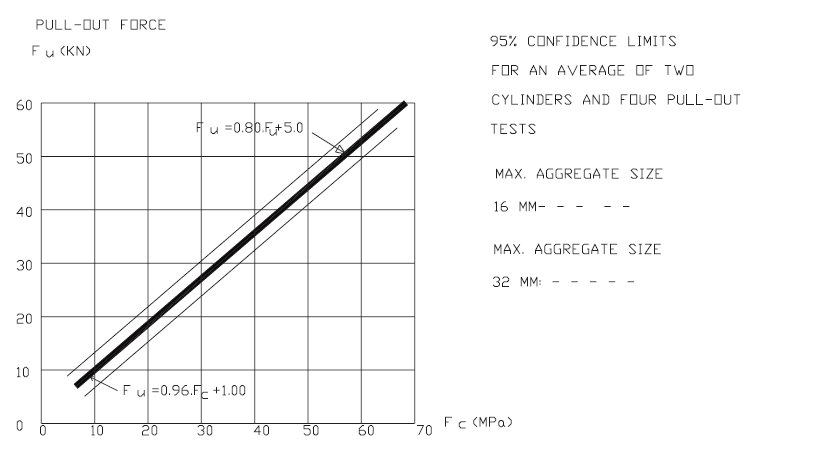The concrete pull out test produces a well-defined failure in the concrete and measures a static strength property of in-situ concrete. The equipment used in concrete pull out test is simple to assemble and operate, but it does require expertise.
In this article, we discuss the procedure of concrete pull out test and its use. Here in this article we also provide information regarding semi-destructive test like LOK Test, CAPO Test, and pull off test.
Also, learn other NDT tests which are used to check the hardened Concrete.
Rebound Hammer Test Procedure
Ultrasonic Testing Procedure
Penetration Resistance Test
Concrete Core Test
Carbonation Test
Chloride Content Test
How to get Idea About Steel Corrosion in Concrete?
Concrete Pull Out Test Procedure:

Courtesy - UDK Gazbeton
The concrete pull out test procedure starts with the fixing of pull out test equipment. The concrete pull out test equipment produce pull out forces which pull the attached cone shape concrete segment. The pull out forces is closely correlated to the compressive strength of concrete. This Correlation is achieved by measuring the pull out force required to pull an embedded steel probe or the disc.
The steel probe or disc is either cast into fresh concrete or installed in hardened concrete, against a circular counter pressure placed on the concrete surface concentric with the disc/ring.
The concrete pull out test method does not provide statistical procedures to estimate other strength properties.
Factors Affecting the Concrete Pull Out Test:
The pull out strength can be related to compressive strength. Such strength relationships are affected by the following factors.
- The arrangement of the embedded insert.
- The dimensions of bearing ring.
- The depth of embedment.
- The type of aggregates uses in concrete.
Before use, the relationships must be established for the test system and a new concrete mixture.
Relation between test strength and compressive strength are more trusted if both concrete pull out test specimens and compressive strength test specimens are of,
- Similar size; and
- Consolidated to similar density, and
- Cured under same conditions.
Use of Concrete Pull Out Test:
Concrete pull out the test is used to estimate the in-situ strength of concrete for the determination of the following point.
- To determine Whether the reinforced concrete structure may be placed into service or
- To determine the strength of concrete for carrying out post- tensioning operations or
- To Measure the time for removal of forms and shores based on the actual strength of the in-situ concrete; or
- To terminate the curing of concrete based on the targeted strength achievement.
- Furthermore, post-installed pull out test may be used to estimate the strength of concrete in existing construction.
The concrete pull out test is done by LOK test method and CAPO Test method. The fundamental principle behind the pull out testing with “Lok Test” and “CAPO Test” is that the test equipment generates pull force on the concrete and produce results that closely correlate to the compressive strength of concrete.
LOK Test:

The principle of LOK Test is same as concrete pull out test. The correlation is achieved by measuring the force required to pull a 25 mm diameter cast in steel disc.
Steel disc is embedded 25 mm in depth in fresh concrete at a time of concreting. The steel disc should be precisely embedded in concrete so that air voids are not formed below the steel disc. Pull bolt is attached to the steel disc and after the curing period, the 25 mm steel disc is pulled until failure of the concrete occurs.
As the LOK Test insert (steel disc) is pulled out, a roughly cone shaped fragment of the concrete is extracted and the pull out force is measured.
This test is carried out for early age strength estimation, to find out the compressive strength with help of calibration curve. It is prepared based on laboratory and field tests conducted on concrete cubes and pull out sample cast with various grades of concrete.
LOK test is one of the famous concrete pull out test, which is used to evaluate structure early age strength of the structure.
CAPO Test:

The principle of capo test is same as concrete pull out test. CAPO Test is also known as “Cut And Pull Out Test”.
In the cut and pull out test, a steel ring is used and expanded into a recessed groove at a depth of 25 mm and is pulled against a counter pressure as with LOK test. A ring is split by sideward cutting at one location, compressed and governed through a centre hole into a 25 mm groove, 25 mm deep, where it is expanded. The groove is recessed in CAPO Test through a centre hole by a diamond drill with the drill bit which is large at the tip.
Measure the pull force from equipment and find out the compressive strength with the help of typical pull force calibration chart.

The CAPO Test method offers greater flexibility for conducting the in-situ concrete test on the hardened concrete of existing structures.
In cut and pull out test, the embedment depth of steel disc and the insert-head diameter have to be equal to inner diameter of the reaction ring which could actually be between 2 to 2.4 times the diameters of the insert-head. The angle between the insert-head diameter and the inside diameter of the reaction ring can be between 54 to 70 degree. The compressive strength can be considered as proportional to the ultimate pull force.
Thus, due to the inherent heterogeneity of concrete, the typical average within-batch coefficient of variation of such pull out tests has been found to be in the range of 7 to 10 percent which is better than that of the standard cube/cylinder compression test.
It is superior to rebound hammer test and penetration test because of greater depth of concrete volume tested.
- Pull Off Test:
In Pull off Test, the traction force (pull force) required to pull off a metallic disc bonded to a surface of the concrete is related to the compressive strength of the material. The traction is axially transmitted to the disc previously bonded to the concrete with the help of resin or adhesive. After a period of time enough to cure the resin or adhesive, a traction force (pull force) is applied to the disc by portable mechanical equipment. The gradual increase of force in MPa can be measured in equipment that has an integrated digital manometer.
The gradual increase in pull force cause breakage and can directly record on a scale and maximum tension is logged, as soon as the pull off of concrete happens. Relate the pull off force with the calibration curves and estimate the compressive strength.
The test was conducted with a surface cut of 5 mm deep according to the dimension of the metallic disc. The surface cut is necessary for the surface which is affected by carbonation effect. The surface needs to be clean before the bonding of metallic disc with concrete.

Major Factor Affecting the Pull Off Test Results:
- Properties of concrete and How Concrete is Made?
- Orientation and position of the aggregate onto the disc
- Presence of coarse aggregates
- The disc materials
- The disc diameter and thickness
- The back pressure system.
- The speed of load application.
The concrete pull off test is feasible to estimate the strength of in-situ concrete. This is based on the correlation values with the compressive strength test. The advantage of the pull off test is that the same equipment is used to measure the bond strength of plaster mortar. The quality of concrete repairs is also determined by the bond strength measurement between the repairing materials and the concrete sub-strata.
The NDT tests like concrete pull out test, LOK test, CAPO test, concrete pull off test, etc, is an appropriate tool in the evaluation of the concrete structure and estimating their strength in-place. The use of the various non-destructive tests, as well as a combination of more than one technique, can be more useful from the viewpoint of the validity of result.